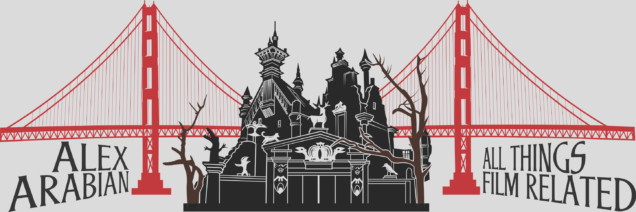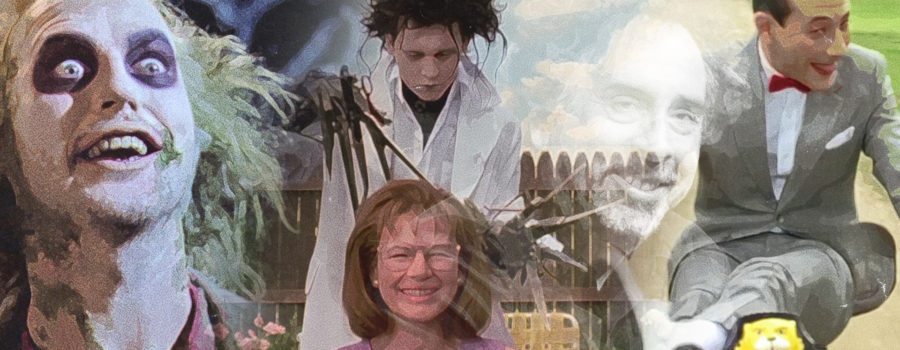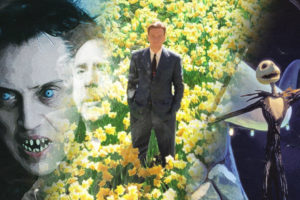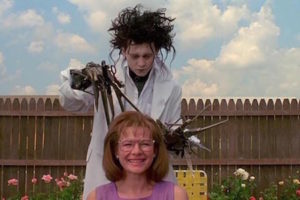[Published at Living Life Fearless] Tim Burton was a gauche teenager who found solace in the creepy comfort of Vincent Price films, classic creature features, and gothic stories such as Mary Shelley‘s Frankenstein. In the suburbs of Burbank, California, often more artistically articulate than verbally, Burton associated more with the societal outcast than he did with the popular students at school – keeping to himself as much as possible, he often sketched and drew to express himself.
As the auteur-in-the-making expanded his cinematic influences, his drawings grew more distinct, intricate, singular. What would become coined as a quintessentially Tim Burton-esque style, as the artist grew up to become a prominent director in his own right, began as the peculiar observations of a pastel-abundant suburbia from an awkward teenager’s perspective. Accompanying the unmistakably eccentric array of visual styles and motifs that Burton has honed over the course of his career are equally nonconformist and novel recurring themes. His adaptive screenwriter for Edward Scissorhands, The Nightmare Before Christmas, and Corpse Bride, Caroline Thompson, said it best in Movieline Magazine: “He’s the most articulate non-verbal person I know.”
Eccentric Suburban Satire
Pastel-Laden Palette, Synchronicity, & Suburban Monotony
Edward Scissorhands
The cars simultaneously pulling out of their driveways with their matching station wagons, driving to work in unison. Passively aggressively competing neighbors mowing their lawns and walking their dogs in step in front of their nearly identical homes. Monotonous activities of retrieving the mail and the newspaper. Consumerism never actually leaves the home in Suburbia, because Suburbia itself is a product of consumerism. It’s a self-refuting paradox.

Everything is a competition in this cul-de-sac of consumerism. The townspeople (stand-ins for the “Frankenstein” villains) compete for Edward’s (Johnny Depp) attention, affection, even his human capital (they let him do their gardening and haircuts for free, taking full advantage of Edward’s naïveté towards the concept of financial currency), and, eventually, sufficient enough credibility to paint him a villain and unwelcome intruder and the crown as new neighborhood savior.
Honorable Mentions
If Edward Scissorhands represents the decay of American Suburbia, then Beetlejuice explores the concept of its profit-driven inception and the seemingly opportunistic who seek to capitalize upon it (Cuesta Verde housing company in Poltergeist, anyone?).
Big Fish: Suburban synchronicity and the navigation and evolution of the post-war American nuclear family.
Starkly Contrasted Color & Diversity Inclusion
Pee-wee’s Big Adventure
In his essay titled, “Man-Child in the Puppet Land,” for The New York Times, J. Hoberman describes Pee-wee (regarding the Pee-wee’s Playhouse TV series) as a naive champion of queer and minority representation:
“As Pee-wee (Paul Reubens) was an adult who acted like a child, so the Playhouse aesthetic blended high and low tech, the avant-garde and the vulgar. Art world precursors and analogues include Betty Boop, Red Grooms, the underground animator Sally Cruikshank, the midnight movie Forbidden Zone, East Village performance art, neo-Pop painters like Kenny Scharf, and Raw magazine (an early publisher of the cartoonist Gary Panter, who was one of the show’s three original production designers).”
“The Playhouse was further distinguished by its racial diversity and frisky gender bending. Jambi the blue-faced genie (John Paragon) and the elaborately be-wigged Miss Yvonne (Lynne Marie Stewart), “the most beautiful woman in Puppet Land,” each in their way evoked drag performers. Dixie the cabdriver (Johann Carlo) and Reba the mail lady (a pre-Law & Order S. Epatha Merkerson) were notably assertive women, while Cowboy Curtis (Laurence Fishburne) and the various hunky beach boys who drifted in and out of the Playhouse were bashful and flirtatious.”

This vibrant world of “misfits” was, in part, what summoned an animation prodigy like Burton to Pee-wee’s Big Adventure, and he successfully captures, and creatively expounds upon, this aesthetic – as well as the continued allegory for queer and minority inclusion.
Honorable Mentions
Edward Scissorhands: Snow as a symbol for the lasting effects of cultural influence and diversity inclusion.
Toxic Consumerism
If Delia and Charles represent the opportunistic in Beetlejuice, then Barbara (Geena Davis) and Adam (Alec Baldwin), the home’s prior residents who died in a car accident, represent the idealist – they moved out to rural Connecticut to get away from the bustle of the city and start a family. The inclusion of the lingering presence of their ghosts – as well as Beetlejuice (Michael Keaton) – reflects the larger consequences of driving out and/or excluding the original population that lived there prior; gentrification isn’t possible without ethical repercussions.

Burton depicts Delia and Charles as idiots who think they can capitalize on a concept even crazier than the nuclear family – ghosts. Alas, these particularly determined ghosts have a wicked sense of humor, and it doesn’t end up well for Delia and Charles.
The Spaces in Between
In all of the above films, Burton is fascinated by the spaces in between. Between eras. Between towns. Between places. Between fiction and realty. Among the Reagan suburban revitalization (and this also holds true in urban areas) there were always places that were whispered about – on the outskirts; at the end of the street; the next town over – that don’t quite fit with the rest of the area or the time period.
Those spaces, and the contrast with our own lives, make us able to see our way of life more clearly. It highlights the absurdity and banality of our postmodern lives, but in Burton’s best work, it also injects a touch of magic back into our otherwise dreary existence.
One film not yet mentioned carries with it one of the most textbook examples of Burton’s use of the magic of the in-between: Big Fish.
Big Fish & the Town of Spectre
“There were two roads out of Ashton, a new one which was paved, and an older one that wasn’t. People didn’t use the old road anymore, and it had developed the reputation of being haunted. Well, Since I had no intention of ever returning to Ashton, this seemed as good a time as any to find out what lay down that old road.” – Ewan McGregor as Ed Bloom in Big Fish.
The road off-the-beaten-path, the one less taken, has become legend through the collective whispers of the curious townspeople of the ordinary Ashton. What lies beyond that road, Spectre, is a town that only remains in the imaginations of people that claim to know about it. Yet for Bloom, it wasn’t a place beyond his reach. According to him, he must “understand the mystery of how a place could feel so strange, and yet so familiar… As difficult as it was to reach Spectre, I was fated to get there eventually. After all, no man can avoid reaching the end of his life.”

Nobody in Spectre appears to grasp the concept of modern-day society, nor do they abide by its rules. The viewer is led to believe that the town symbolizes heaven, at first, but no place, no matter how elusive or free-spirited it may seem, is immune from the effects of an economic recession. Spectre may not be what it seems in Big Fish, but that doesn’t mean its ideals don’t live on by the film’s end.
The Artistic Outsider
Ed Wood & the Horrible Filmmaker
In his mind, Edward D. Wood Jr. (Depp) is a bonafide genius, a Tim Burton-esque visionary. If only everyone else felt the same way. His blind naïveté, bordering on willful ignorance, pushes people – friends, collaborators, industry professionals – away.

This selective hearing, if you will, also a quality that allowed him to get away with so much at the expense of the various studios involved in his films. Ed Wood isn’t just about a man with objectively poor artistic taste. It’s also an earnest biopic delving into the life of a cross-dresser who had to hide who he really was during an oppressive time in American history.
Honorable Mentions
Charlie and the Chocolate Factory: Willy Wonka (Depp) isn’t solely an inventor, he’s a culinary artist. A visionary. Not unlike Burton is with a pencil and a camera. His various Howard Hughes-esque neuroses and paranoias keep him closed off from the rest of society.
Edward Scissorhands: Edward is the misunderstood genius. His garden sculptures and unique haircuts (which he effortlessly creates) are works of immense talent taken for granted by the neighborhood. Awkward and disfigured among his “normal” peers, he is a passing fad – a trend – for the vanilla neighborhood.
In Part 2 we’ll be exploring Burton’s thematic use of a suspended childhood, gothic undertones, and the irreplaceable contributions of Danny Elfman…








Leave a Reply
Your email is safe with us.